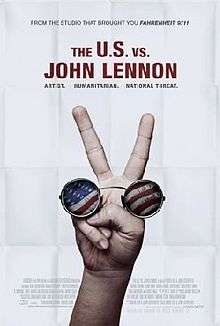The U.S. vs. John Lennon
| The U.S. vs. John Lennon | |
|---|---|
 | |
| Directed by |
David Leaf John Scheinfeld |
| Produced by |
David Leaf John Scheinfeld |
| Written by |
David Leaf John Scheinfeld |
| Starring | see cast section |
| Music by | John Lennon |
| Cinematography | James Mathers |
| Edited by | Peter S. Lynch II |
Production company |
Authorized Pictures |
| Distributed by | Lionsgate |
Release dates |
|
Running time | 99 minutes |
| Country | United States |
| Language | English |
| Box office | $1,408,065[1] |
The U.S. vs. John Lennon is a 2006 documentary film about English musician John Lennon's transformation from a member of The Beatles to a rallying anti-war activist striving for world peace during the late 1960s and early 1970s. The film also details the attempts by the United States government under President Richard Nixon to silence him. The film had its world premiere at the Venice Film Festival and its North American premiere at the Toronto International Film Festival. It was released in New York City and Los Angeles, California on 15 September 2006, and had a nationwide release on 29 September. A soundtrack composed of John Lennon tracks was released by Capitol Records and EMI on 26 September 2006.
The film makes extensive use of archival footage of Lennon and Yoko Ono, and includes a famously hard-hitting interview conducted by anti-war reporter Gloria Emerson.[2]
The U.K. release was on December 8, 2006, 26 years to the day after the death of John Lennon. The DVD was released on February 13, 2007 in the United States. The film made its cable television debut in the U.S. on August 18, 2007 on VH1 Classic.
Overview
The film explores the political activism that Lennon became strongly involved in with the Beatles, and after the band ended.
John Lennon is established as being a potential political threat to the American government, and therefore much of the film covers the theme of 'silencing' him and other popular figures that became involved in anti-war activism. Throughout the film the audience can see both sides of the situation: the audience sees the protests and events Lennon and Yoko Ono organised, such as the famous "Give Peace a Chance" rally and concepts such as bagism and bed peace.
We also see the increasing fear experienced by the US government and CIA. This build-up of paranoia and fear for control led to the eventual deportation notice sent to John Lennon's house, informing him that 'his temporary stay in the USA was now over'. The film debunks and exposes the somewhat bizarre behaviour of the CIA and police department over John Lennon and other contemporary figures' behaviour, referring also to different modern issues like drug abuse.
The film features a montage of various mediums. There are videos of performances of songs and interviews of Lennon at the time, recordings of Yoko Ono both present and from the late 1960s and 1970s, as well as a basic story structure of retelling the story of John Lennon's attempts to spread a message of peace amongst the USA and, on a wider scale, the entire Western world during the Vietnam War.
Cast
- Tariq Ali
- Carl Bernstein
- Noam Chomsky
- Walter Cronkite
- Mario Cuomo
- Angela Davis
- John Dean
- David Fenton
- Ron Kovic
- John Lennon
- G. Gordon Liddy
- George McGovern
- Elliot Mintz
- Richard Nixon
- Yoko Ono
- Geraldo Rivera
- Bobby Seale
- Tom Smothers
- Gore Vidal
Soundtrack
Reviews
- Sam Adams, MOVIE REVIEW: The U.S. vs. John Lennon, Los Angeles Times, September 15, 2006.
- Rotten Tomatoes review
References
- ↑ "The U.S. Vs. John Lennon (2006)". Box Office Mojo. Retrieved July 12, 2011.
- ↑ Lions Gate tunes in Lennon documentary, Daily Variety, September 2, 2005.
External links
- The U.S. vs. John Lennon at the Internet Movie Database
- The U.S. vs. John Lennon at AllMovie
- The U.S. vs. John Lennon at Rotten Tomatoes
- Official website